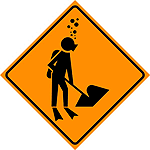|
| |

|
|
| < Prev. month |
Next month > |

|
This page under construction.
Here are some of the topics that will be covered in this chapter. More text and images will eventually be added to this section. Thank you for your patience.
|
- With warmer water, less nutrients, and less water motion, giant kelp begins to grow more slowly. Some blades weaken and are overgrown by epiphytic algae, bryozoans, hydroids, and fungi. Large populations of burrowing animals may weaken the kelp holdfasts as well. Senescence of the kelp blades and lack of nutrients is often most severe in sheltered areas with reduced water circulation.
- Bull kelp releases spores after its stipes reach the surface. These spores form in darker patches on the blades of the kelp called "sori", which eventually "rot" out of the plant, releasing the spores, typically around dawn (when the sea is most calm). Porphyra nereocystis, an epiphyte on bull kelp, also spawns at this time of year.
- Understory algae growing under giant kelp remain lush, with as many as four different layers of algae within the kelp forest: At the top is the canopy of giant kelp (the "big trees" of the kelp forest). Below the main canopy, large brown algae such as Laminaria and Pterygophora have grown tall enough (10 to 15 feet tall) to form a middle layer of "smaller trees." Beneath these, smaller (1- to 2-foot high) red algae such as Rhodymenia and Plocamium form a sort of underwater "shrubbery." Finally, coralline red algae and foliose red algae form a low-growing "turf" several inches thick that covers any portion of the seafloor not occupied by other algae.
- Many annual understory algae (e.g. Cystoseira osmundacea) release spores in fall. Many of these are consumed by purple sea urchins, but those that survive will sprout during next year's spring.

|
| |
